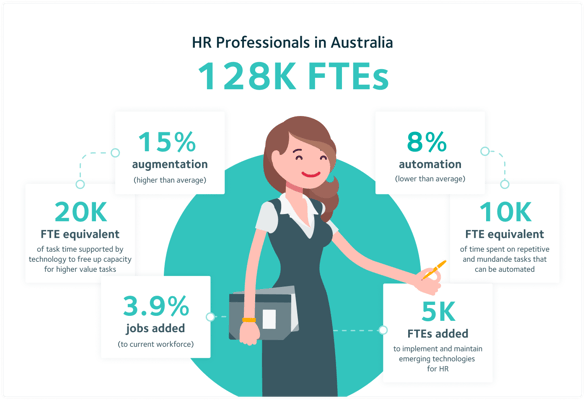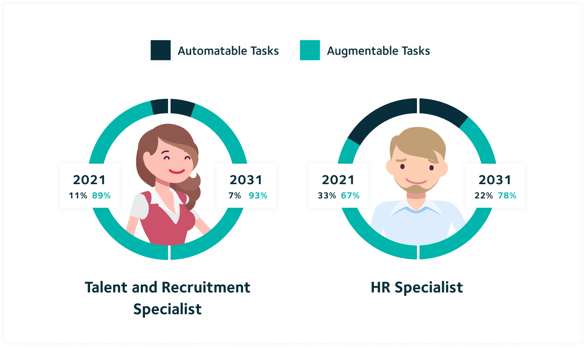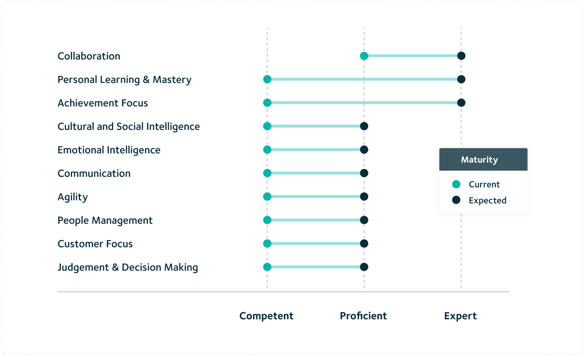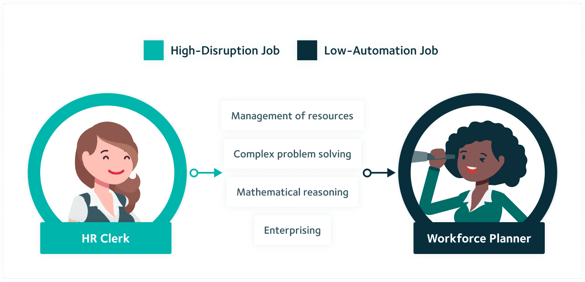Workforce planning is an emerging and highly sought after skill in the HR sector. Workforce...
Preparing for HR AI & Automation: New Opportunities for HR to Lead
The commercial availability of artificial intelligence and other emerging technologies is profoundly changing work as we know it. It’s a pivotal moment for the human resources department. Today, HR leaders play a key role in decision-making at the most senior levels to ensure that technology adoption occurs in parallel with reskilling and redeployment, not replacement and redundancy.
It’s the HR department’s responsibility to understand:
- the extent to which existing jobs will be completely replaced or profoundly transformed by technology
- which new jobs must be added to support the technologies rolled out in their workplace
- which skills are transferable to other roles, and which are important to the future of work
- which critical digital and data literacy skills their people need to work effectively with new technologies
The future for HR
And it’s a good question, because it turns out HR professionals are very well-positioned to benefit from emerging technologies. Our analysis of HR jobs in Australia shows that while the automation rate is lower than average, most jobs in HR have a higher-than-average augmentation rate - enhancing their productivity and efficiency. What else did the data show us about the future for HR? We took a look at how technology is likely to impact HR professionals, what those technologies are, how HR roles might evolve over time and where the biggest gaps in HR's future capabilities exist.
In the next five years
Right now in Australia, there are a total of 128,000 FTEs in HR roles across every industry. In the next five years, this number will grow by about 3.9 per cent - adding nearly 5,000 FTEs as a direct consequence of emerging technologies.
The automation rate of FTEs in HR is lower than average, at just eight per cent. That will impact around 10,000 FTEs - the FTE equivalent of time spent on repetitive and mundane tasks that can be automated. Augmentation is a far more impactful technology on HR tasks, with a higher than average augmentation rate of 15 per cent. In five years’ time, around 20,000 FTEs will be impacted - that’s the FTE equivalent of task time supported by technology to free up capacity for higher value tasks.

Which technologies are most likely to impact the HR function in the future?
Talk to any HR professional and they’ll have multiple examples of how the digitalisation of their office is freeing them up to take on more strategic, high-value work. Tasks such as reporting, applicant evaluation and job matching once took days and weeks to complete. Now, reports can be produced instantly while repetitive, manual tasks are reduced to just a few hours.
Leading learning company Pearson has been using the Faethm workforce analytics platform to inform their strategic workforce planning, giving them the predictive data they need to understand how emerging technologies will impact their people. Within the HR division, automation has impacted day-to-day work in enormously positive ways.
Simone Wright, VP of Human Resources at Pearson, says that, “ … tasks that used to take hours, including manual data inputs and manual manipulation, are declining as machine learning and robotics doing those mundane tasks are able to do them faster and quicker. Now you can click a button and you've got a dashboard. As long as you're asking the right questions and you've got the right KPIs, you've got access to data much more quickly and can derive deeper insights and better understanding of issues by freeing up capacity.”
Automation technology today assists HR professionals to review and evaluate applicant qualifications, while augmentation technology assists HR professionals to match job applicants with job requirements and interpret human resources policies, procedures, laws, and other regulations.
Of all the emerging AI technologies, Process Automation is most likely to have the greatest impact on HR tasks. In fact, it’s predicted to impact 74 per cent of all HR tasks within the next five years. In HR, Process Automation is most commonly the types of software that assist with on-boarding, payroll actions, processing errors, and data compliance issues.
While technological transformation leads to greater professional fulfilment, it also increases the need for people to build new skills and adapt to new ways of working as their roles transform. To fully leverage technologies, and keep pace with the rapid evolution of these technologies, HR professionals must embrace lifelong learning.
How will roles in the HR function evolve over time through digital transformation?
Technology impacts on the HR function will vary, but our analysis reveals a common trend across all HR roles. Over the next ten years, automatable tasks will decrease, while augmentable tasks will increase as a proportion of the job.
Take this example of the difference in ten years' time to the increased augmentation rate of Talent & Recruitment Specialist and HR Specialist tasks. The Talent & Recruitment Specialist shows an increase of four per cent augmentation in 2031, while the HR Specialist's tasks are 11 per cent more augmentable.

Technology adoption leads to job growth for HR
When it comes to digital transformation and HR, Faethm’s insights show that for every 100 new roles added to an organisation to implement and support new technologies, seven new roles should be added to HR. These new roles are needed to support the increased headcount as well as the growing complexity of workforce planning.
The fast pace of technology adoption is forecast to grow HR jobs to the extent that by 2026, more than 25,000 FTEs will be needed to fill those new jobs. Of all those new jobs, the five with the highest expected job growth are:
- HR managers and analysts
- Workforce planners
- Training and development managers
- Employment program coordinators
- Talent and recruitment managers
These insights are invaluable for your employee development and internal mobility plans. With such high job growth, it's essential for every HR leader to retain their team so that they have a talent pool in place to quickly fill growing and in-demand roles. And the ideal way to do that is by preparing their team, through upskilling and reskilling, for these future jobs.
What are the biggest future capability gaps in HR?
To make the most of internal career pathways, as well as take on high value tasks and added responsibilities in current roles, HR professionals must improve the proficiency of their future capabilities.
Future capabilities are integral to a successful transition to the future of work. They are the innate human attributes that no robot can replace, and the digital literacies needed to succeed in an increasingly digitised and data-driven workplace.
Using Faethm’s Future Capabilities assessment, we identified the ten most important future capabilities for HR professionals. Each of these requires upskilling to reach the Expert and Proficient maturity levels needed in five years’ time in order to stay relevant.
 By upskilling and reskilling in advance, Pearson’s HR team has been able to take a leading role in steering their company through the disruptions of both digitalisation and the pandemic. Ms Wright says, “What I have seen is that we're adding additional responsibilities and able to do more data-driven insight gathering. At the same time, I'm sure it hasn't gotten any slower in HR this year. It's speeding up all the time and the opportunity for us as a community to make an impact on business performance is just growing, I think, post COVID."
By upskilling and reskilling in advance, Pearson’s HR team has been able to take a leading role in steering their company through the disruptions of both digitalisation and the pandemic. Ms Wright says, “What I have seen is that we're adding additional responsibilities and able to do more data-driven insight gathering. At the same time, I'm sure it hasn't gotten any slower in HR this year. It's speeding up all the time and the opportunity for us as a community to make an impact on business performance is just growing, I think, post COVID."
Internal mobility should be a part of every career plan
Faethm’s Job Corridor is an essential tool for every HR leader who's preparing their internal mobility strategy. The Job Corridor suggests alternate internal career pathways for jobs most likely to be automated.
Having seen the capability of the the Job Corridor, which provides a great focus for any workforce, Ms. Wright says, “I think the important thing for HR to understand is that this is a great thing about learning and while we help others in the business, we can also grow and develop within our own profession. What are those skills that we actually have today in our roles that can help pathway us to the next level or other job functions - and build on those skills that will enable us to continue to grow and move our careers as we learn more about our gaps."
The career pathway example below takes a look at the HR Clerk role, which is experiencing huge disruption from automation. HR Clerks could be retained by using the Job Corridor to identify skills in the role that are transferable to less at-risk HR roles.

Every job transition in the Job Corridor is rated by job fit, which is determined by the level of similarity in the tasks and skills between two roles - that is, how transferable the skills are from the current job to the target job. The total job fit score is modelled on a range of data points, including the size of the skills gaps, automation risk and potential for future economic growth. To improve the success of a transition, the Job Corridor can be used to identify where the skills gaps lie to provide targeted upskilling.
Does your organisation have the right HR talent in place to support your digital transformation?
The high demand for HR professionals is here to stay. In every successful digital transformation project, you’ll find the HR function providing critical support. The people agenda has to be linked to the CIO’s agenda for a successful technology adoption outcome.
However, in many large companies, a truly effective people and technology partnership isn't common. After 25 years in the technology industry, Greg Miller, Executive Director and Co-Founder of Faethm, has seen this play out repeatedly, and says the solution to a productive partnership lies with Faethm.
“The need to bridge their strategies in real time requires a significant amount of collaboration and the capability to see the other view and to bring people together under a common thread and a common mission. We can arm you with data that, at the executive table, is meaningful and empowering. The power of data and insights can create that bridge between the CHRO and the CIO,” Mr Miller says.
Ms. Wright agrees that cross-collaboration is critical to solving key business challenges, saying, “How we can advance HR is through that collaborative effort with the technology teams and the data scientists that align us all in the direction of solving a problem that we might be looking at for our business.”
She’s made a point of connecting the HR operations and analytics teams, “ … so that we can pose those big questions. I think that the value that they can bring to us is to help us navigate the data that we have, which is quite rich, and extract the insights. It's a lot of what Faethm has been helping us with as well."
Faethm puts HR leaders at the centre of the organisation
Faethm is integral to the success of HR’s long-term workforce strategies. Workforce data is a rich source of intelligence, and by applying Faethm’s predictive AI, it’s possible to gain a highly granular view of how each employee’s job could be automated and augmented - up to 15 years into the future.
The insights delivered by Faethm’s platform add value to every area of the business, driving strategic workforce planning, technology adoption strategies, learning and development programs, and a sustainable automation agenda. And this puts HR at the centre of every organisation’s plans for their people and the future of work.
Forward-thinking leaders want to know what the reality of those impacts will be, and how they can prepare their people for that reality. Faethm answers these questions with data science and AI. Faethm’s predictive HR analytics platform can assess any workforce to surface the impacts of external forces, including emerging technologies and COVID-19.
Faethm has the world’s only model of the transformation of work over time and our future of work predictive analytics is recognised globally as a world first.
Contact us today for a demo of the platform.
Further Reading
If you enjoyed this check out Faethm and Boston Consulting Group's The Future of Jobs in the Era of AI report.



